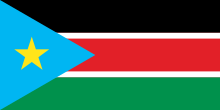 Flag of South Sudan | |
| Data | |
|---|---|
| Water coverage (broad definition) | (improved water source) c. 50% |
| Continuity of supply | not available |
| Average urban water use (L/person/day) | not available |
| Average urban water and sanitation tariff (US$/m3) | not available |
| Share of household metering | low |
| Annual investment in WSS | unknown |
| Share of self-financing by utilities | low to none |
| Share of tax-financing | low to none |
| Share of external financing | high |
| Institutions | |
| Decentralization to municipalities | No |
| National water and sanitation company | South Sudan Urban Water Corporation (SSUWC) |
| Water and sanitation regulator | None |
| Responsibility for policy setting | Ministry of Water Resources and Irrigation |
| Sector law | No |
Water supply in Southern Sudan is faced with numerous challenges. Although the White Nile runs through the country, water is scarce during the dry season in areas that are not located on the river.
About half the population does not have access to an improved water source, defined as a protected well, standpipe or a handpump within 1 km. The few existing piped water supply systems are often not well maintained and the water they provide is often not safe to drink.
Displaced people returning home put a huge strain on infrastructure, and the government institutions in charge of the sector are weak. Substantial external funding from numerous government agencies and non-governmental organizations is available to improve water supply.